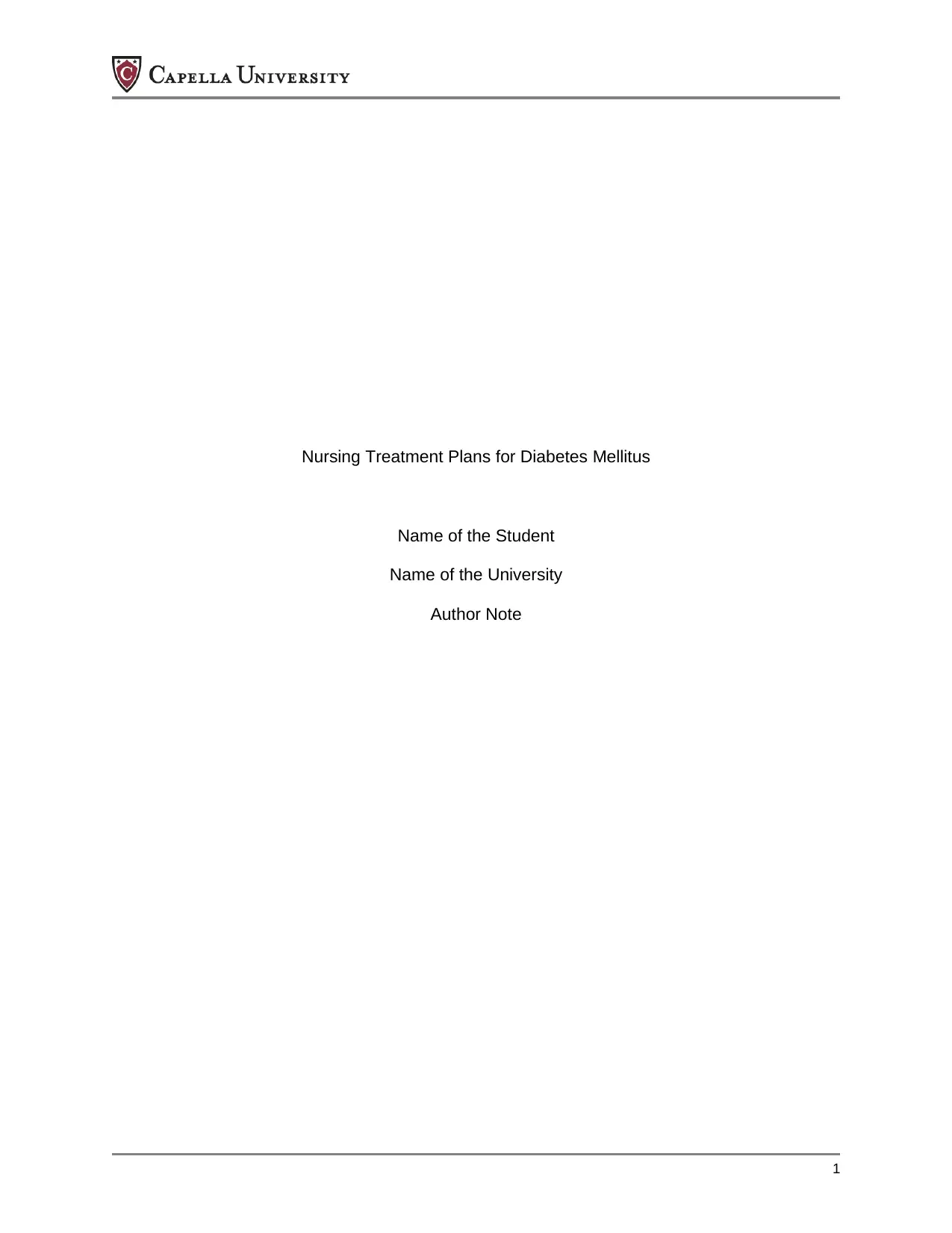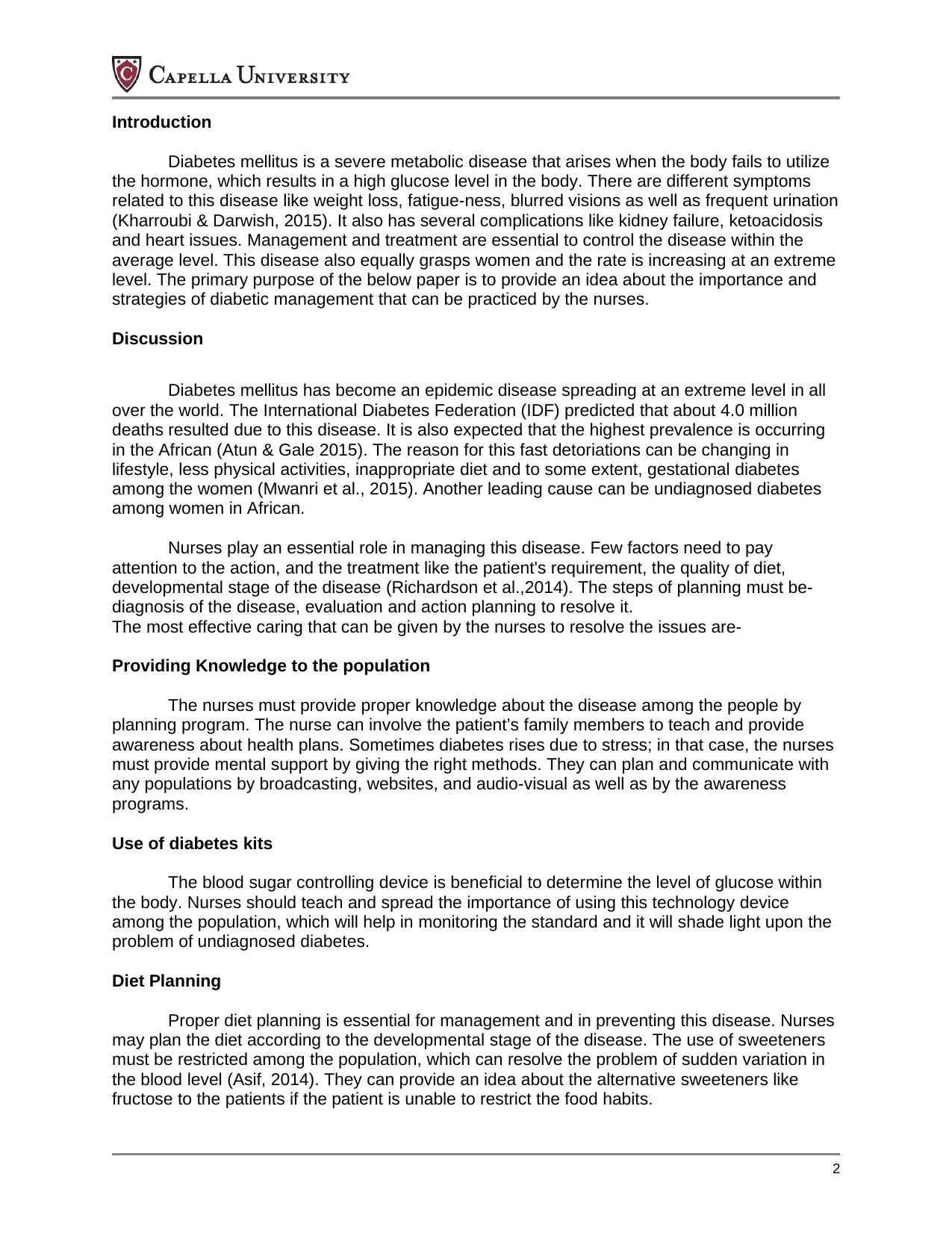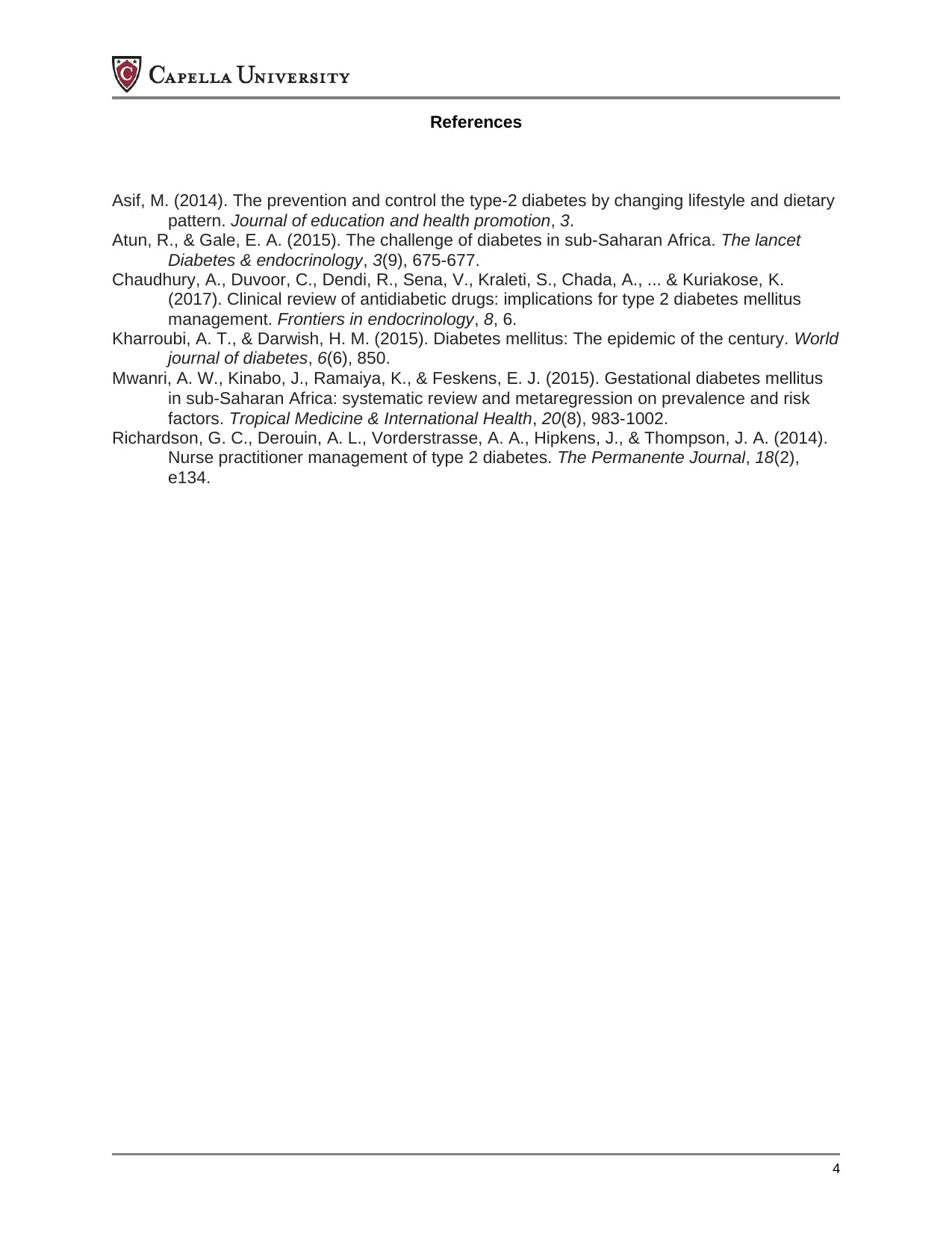Nursing Strategies for Diabetes Mellitus Treatment Plans
VerifiedAdded on 2022/08/13
|4
|1187
|18
Report
AI Summary
This report delves into the management of Diabetes Mellitus, focusing on the crucial role of nurses in providing effective treatment plans. The paper begins by defining the disease and its complications, emphasizing the increasing prevalence, particularly among women in Africa. It then outlines several key strategies for nurses to implement, including providing health education, promoting the use of blood glucose monitoring devices, planning appropriate diets, administering medication, encouraging physical activities, and conducting regular health check-ups. The report highlights the importance of government support in providing free medications and implementing awareness programs. The plans discussed are cost-effective and can be easily adopted, focusing on communication and team involvement to improve outcomes. The paper concludes by summarizing the discussed strategies, underscoring the significance of a multi-faceted approach to manage diabetes and improve the quality of life for affected individuals. The report also references the government program which is applied to resolve the high rate among the population.

Nursing Treatment Plans for Diabetes Mellitus
Name of the Student
Name of the University
Author Note
1
Name of the Student
Name of the University
Author Note
1
Paraphrase This Document
Need a fresh take? Get an instant paraphrase of this document with our AI Paraphraser

Introduction
Diabetes mellitus is a severe metabolic disease that arises when the body fails to utilize
the hormone, which results in a high glucose level in the body. There are different symptoms
related to this disease like weight loss, fatigue-ness, blurred visions as well as frequent urination
(Kharroubi & Darwish, 2015). It also has several complications like kidney failure, ketoacidosis
and heart issues. Management and treatment are essential to control the disease within the
average level. This disease also equally grasps women and the rate is increasing at an extreme
level. The primary purpose of the below paper is to provide an idea about the importance and
strategies of diabetic management that can be practiced by the nurses.
Discussion
Diabetes mellitus has become an epidemic disease spreading at an extreme level in all
over the world. The International Diabetes Federation (IDF) predicted that about 4.0 million
deaths resulted due to this disease. It is also expected that the highest prevalence is occurring
in the African (Atun & Gale 2015). The reason for this fast detoriations can be changing in
lifestyle, less physical activities, inappropriate diet and to some extent, gestational diabetes
among the women (Mwanri et al., 2015). Another leading cause can be undiagnosed diabetes
among women in African.
Nurses play an essential role in managing this disease. Few factors need to pay
attention to the action, and the treatment like the patient's requirement, the quality of diet,
developmental stage of the disease (Richardson et al.,2014). The steps of planning must be-
diagnosis of the disease, evaluation and action planning to resolve it.
The most effective caring that can be given by the nurses to resolve the issues are-
Providing Knowledge to the population
The nurses must provide proper knowledge about the disease among the people by
planning program. The nurse can involve the patient’s family members to teach and provide
awareness about health plans. Sometimes diabetes rises due to stress; in that case, the nurses
must provide mental support by giving the right methods. They can plan and communicate with
any populations by broadcasting, websites, and audio-visual as well as by the awareness
programs.
Use of diabetes kits
The blood sugar controlling device is beneficial to determine the level of glucose within
the body. Nurses should teach and spread the importance of using this technology device
among the population, which will help in monitoring the standard and it will shade light upon the
problem of undiagnosed diabetes.
Diet Planning
Proper diet planning is essential for management and in preventing this disease. Nurses
may plan the diet according to the developmental stage of the disease. The use of sweeteners
must be restricted among the population, which can resolve the problem of sudden variation in
the blood level (Asif, 2014). They can provide an idea about the alternative sweeteners like
fructose to the patients if the patient is unable to restrict the food habits.
2
Diabetes mellitus is a severe metabolic disease that arises when the body fails to utilize
the hormone, which results in a high glucose level in the body. There are different symptoms
related to this disease like weight loss, fatigue-ness, blurred visions as well as frequent urination
(Kharroubi & Darwish, 2015). It also has several complications like kidney failure, ketoacidosis
and heart issues. Management and treatment are essential to control the disease within the
average level. This disease also equally grasps women and the rate is increasing at an extreme
level. The primary purpose of the below paper is to provide an idea about the importance and
strategies of diabetic management that can be practiced by the nurses.
Discussion
Diabetes mellitus has become an epidemic disease spreading at an extreme level in all
over the world. The International Diabetes Federation (IDF) predicted that about 4.0 million
deaths resulted due to this disease. It is also expected that the highest prevalence is occurring
in the African (Atun & Gale 2015). The reason for this fast detoriations can be changing in
lifestyle, less physical activities, inappropriate diet and to some extent, gestational diabetes
among the women (Mwanri et al., 2015). Another leading cause can be undiagnosed diabetes
among women in African.
Nurses play an essential role in managing this disease. Few factors need to pay
attention to the action, and the treatment like the patient's requirement, the quality of diet,
developmental stage of the disease (Richardson et al.,2014). The steps of planning must be-
diagnosis of the disease, evaluation and action planning to resolve it.
The most effective caring that can be given by the nurses to resolve the issues are-
Providing Knowledge to the population
The nurses must provide proper knowledge about the disease among the people by
planning program. The nurse can involve the patient’s family members to teach and provide
awareness about health plans. Sometimes diabetes rises due to stress; in that case, the nurses
must provide mental support by giving the right methods. They can plan and communicate with
any populations by broadcasting, websites, and audio-visual as well as by the awareness
programs.
Use of diabetes kits
The blood sugar controlling device is beneficial to determine the level of glucose within
the body. Nurses should teach and spread the importance of using this technology device
among the population, which will help in monitoring the standard and it will shade light upon the
problem of undiagnosed diabetes.
Diet Planning
Proper diet planning is essential for management and in preventing this disease. Nurses
may plan the diet according to the developmental stage of the disease. The use of sweeteners
must be restricted among the population, which can resolve the problem of sudden variation in
the blood level (Asif, 2014). They can provide an idea about the alternative sweeteners like
fructose to the patients if the patient is unable to restrict the food habits.
2

Medication
Diabetes can be controlled by the regular use of anti-diabetic drugs or injections
(Chaudhury et al.,2017). However, there are many restrictions observed among the patient for
accepting daily medication. Nurses must emphasize the usefulness of the drugs and injections
among the patients. Proper handling of the equipment must be done as the different device has
a different way of processing, the nurse must provide complete knowledge about the method as
well as its route of administration and dose among the patients.
Health Check-up and Physical Activities
Maintenance of health is one of the critical factors in checking diabetes. Nurses must
demonstrate some physical activities among the patients, which will help resolve the problem of
obesity among the patient. Monthly, health check-ups can be advised by the nurses to check
the level of glucose. The team of a nurse can provide a reminder message after hospital
discharge or last check-up to the patient.
The plans are very cost operative and do not necessitate much money subsidies. The
actions to care and resolve is mainly by communication and by preparation of programs.
However, team involvement will be useful in applying the intervention.
Government Steps
The International Diabetes Federation African Region launched a Programme named
“Diabetes Declaration and Strategy for African,” it helped the region to improve the quality of life,
reduce death. However, the government must plan to supply free drugs to the patients across
Africa especially in the lower society in order to resolve the problem.
Conclusion
The above paper discussed Diabetes Mellitus and its management strategy by nurses.
The disease has many complications, which results in an increased level of glucose in the
blood. The rate is quite high among the African Women population. The management programs
can provide proper knowledge about the disease among the people, can teach using modern
equipment’s as well as giving reminder for the check-up. The process is cost-effective and can
be adopted. Lastly, the paper discussed the government program can is applied to resolve the
high rate among the population.
3
Diabetes can be controlled by the regular use of anti-diabetic drugs or injections
(Chaudhury et al.,2017). However, there are many restrictions observed among the patient for
accepting daily medication. Nurses must emphasize the usefulness of the drugs and injections
among the patients. Proper handling of the equipment must be done as the different device has
a different way of processing, the nurse must provide complete knowledge about the method as
well as its route of administration and dose among the patients.
Health Check-up and Physical Activities
Maintenance of health is one of the critical factors in checking diabetes. Nurses must
demonstrate some physical activities among the patients, which will help resolve the problem of
obesity among the patient. Monthly, health check-ups can be advised by the nurses to check
the level of glucose. The team of a nurse can provide a reminder message after hospital
discharge or last check-up to the patient.
The plans are very cost operative and do not necessitate much money subsidies. The
actions to care and resolve is mainly by communication and by preparation of programs.
However, team involvement will be useful in applying the intervention.
Government Steps
The International Diabetes Federation African Region launched a Programme named
“Diabetes Declaration and Strategy for African,” it helped the region to improve the quality of life,
reduce death. However, the government must plan to supply free drugs to the patients across
Africa especially in the lower society in order to resolve the problem.
Conclusion
The above paper discussed Diabetes Mellitus and its management strategy by nurses.
The disease has many complications, which results in an increased level of glucose in the
blood. The rate is quite high among the African Women population. The management programs
can provide proper knowledge about the disease among the people, can teach using modern
equipment’s as well as giving reminder for the check-up. The process is cost-effective and can
be adopted. Lastly, the paper discussed the government program can is applied to resolve the
high rate among the population.
3
⊘ This is a preview!⊘
Do you want full access?
Subscribe today to unlock all pages.

Trusted by 1+ million students worldwide

References
Asif, M. (2014). The prevention and control the type-2 diabetes by changing lifestyle and dietary
pattern. Journal of education and health promotion, 3.
Atun, R., & Gale, E. A. (2015). The challenge of diabetes in sub-Saharan Africa. The lancet
Diabetes & endocrinology, 3(9), 675-677.
Chaudhury, A., Duvoor, C., Dendi, R., Sena, V., Kraleti, S., Chada, A., ... & Kuriakose, K.
(2017). Clinical review of antidiabetic drugs: implications for type 2 diabetes mellitus
management. Frontiers in endocrinology, 8, 6.
Kharroubi, A. T., & Darwish, H. M. (2015). Diabetes mellitus: The epidemic of the century. World
journal of diabetes, 6(6), 850.
Mwanri, A. W., Kinabo, J., Ramaiya, K., & Feskens, E. J. (2015). Gestational diabetes mellitus
in sub‐Saharan Africa: systematic review and metaregression on prevalence and risk
factors. Tropical Medicine & International Health, 20(8), 983-1002.
Richardson, G. C., Derouin, A. L., Vorderstrasse, A. A., Hipkens, J., & Thompson, J. A. (2014).
Nurse practitioner management of type 2 diabetes. The Permanente Journal, 18(2),
e134.
4
Asif, M. (2014). The prevention and control the type-2 diabetes by changing lifestyle and dietary
pattern. Journal of education and health promotion, 3.
Atun, R., & Gale, E. A. (2015). The challenge of diabetes in sub-Saharan Africa. The lancet
Diabetes & endocrinology, 3(9), 675-677.
Chaudhury, A., Duvoor, C., Dendi, R., Sena, V., Kraleti, S., Chada, A., ... & Kuriakose, K.
(2017). Clinical review of antidiabetic drugs: implications for type 2 diabetes mellitus
management. Frontiers in endocrinology, 8, 6.
Kharroubi, A. T., & Darwish, H. M. (2015). Diabetes mellitus: The epidemic of the century. World
journal of diabetes, 6(6), 850.
Mwanri, A. W., Kinabo, J., Ramaiya, K., & Feskens, E. J. (2015). Gestational diabetes mellitus
in sub‐Saharan Africa: systematic review and metaregression on prevalence and risk
factors. Tropical Medicine & International Health, 20(8), 983-1002.
Richardson, G. C., Derouin, A. L., Vorderstrasse, A. A., Hipkens, J., & Thompson, J. A. (2014).
Nurse practitioner management of type 2 diabetes. The Permanente Journal, 18(2),
e134.
4
1 out of 4
Related Documents
Your All-in-One AI-Powered Toolkit for Academic Success.
+13062052269
info@desklib.com
Available 24*7 on WhatsApp / Email
![[object Object]](/_next/static/media/star-bottom.7253800d.svg)
Unlock your academic potential
Copyright © 2020–2025 A2Z Services. All Rights Reserved. Developed and managed by ZUCOL.





